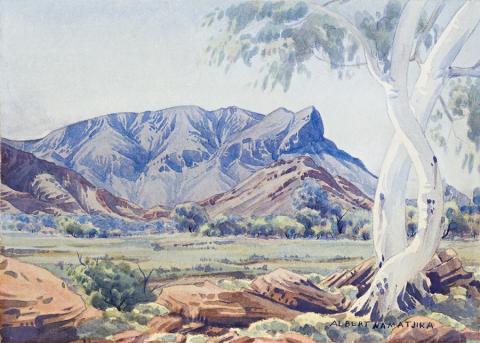MCDONNELL RANGES, 1950
Albert Namatjira
watercolour on paper
26.5 x 37.0 cm
signed lower right: ALBERT NAMATJIRA
Acquired directly from the artist by the pioneering Australian film maker Charles Chauvel who was visiting Alice Springs while scouting for locations for the film Jedda
Thence by descent
Private collection, Queensland
This painting is accompanied by two black and white photographs which were taken at the time the painting was acquired.
There are few Australian artists that can be heralded as the founder of a movement in the same manner as Albert Namatjira. When he passed away in 1959 at the age of 57, the address at his funeral given by Paster Albrecht noted that 'His [Namatjira's] passing, within hours, was flashed as news from one corner of our vast continent to the other... Albert, as we called him, was not only a member of the Aranda tribe and the Lutheran church - I venture to say he was not looked upon as belonging to Australia only: He was a world figure.'1
Achieving popular success from his first exhibition in 1938, Namatjira's particular vision of the Australian landscape was to become lodged in the imagination of the public by the 1950s. Through a series of extremely popular reproductions, his images were widely disseminated and both 'created and reflected a new Australian mythology.'2 His work was informed not by the particular dictates of fashionable trends, but rather from a visual and spatial response to country known intimately by him. Whilst Namatjira adopted the visual language of Western landscape painters, his relationship to the subject is founded on more than aesthetic appreciation.
Deceptively simple, Namatjira's works are imbued with multiple meanings. They are delicate and highly considered images which document the complexities of both spiritual and ecological survival. Trees, present here in our painting of the McDonnell Ranges, play a pivotal role in his compositions. Both a device for opening and framing the picture plane to reveal its inner recesses, the tree itself constitutes the subject in its own right. As Curator Anne French notes 'These paintings are portraits of living entities in their environment.'
The sphere of Namatjira's influence can be observed not only in the manner in which Australian's perceived the country they lived in, but also in his continuing legacy amongst Aboriginal artists. From the Hermannsburg potters to the art of Ginger Riley Munduwalawala, the impact of Namatjira's work continues to resonate throughout contemporary art practise.
1. Albrecht, F.W., 'an address at the funeral of Albert Namatjira in Alice Springs', 9 August 1959, typescript, Battarbee Archive, 3.36/1959
2. French, A., We've got to follow that old man's tracks: Engaging with the Art of Albert Namatjira, One Sun, One Moon, Aboriginal Art in Australia, Art Gallery of New South Wales, 2007, p. 161
